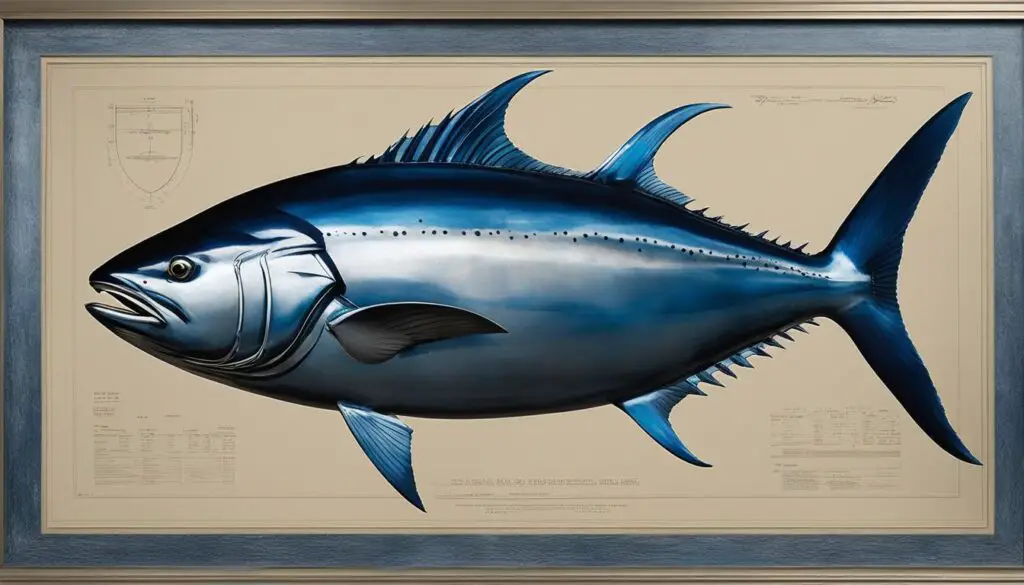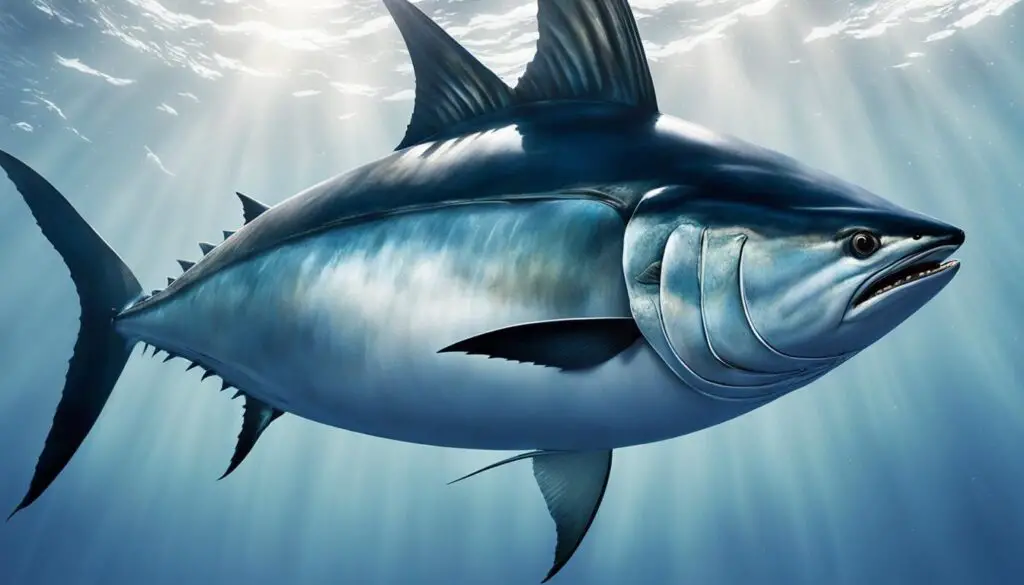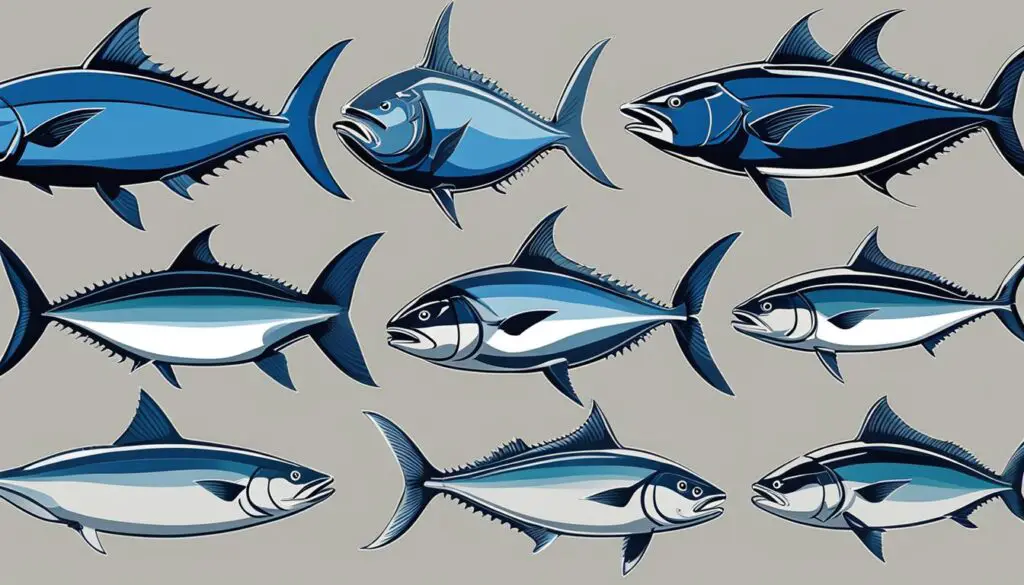Welcome to our exploration of the majestic bluefin tuna! In this article, we will delve into the impressive weight of these enormous creatures and uncover fascinating facts about their size, appearance, habitat, and conservation. If you’ve ever wondered just how much bluefin tuna weigh, you’ve come to the right place!
Key Takeaways:
- Bluefin tuna can reach lengths of 6.5 feet and weigh around 550 pounds on average.
- Larger specimens have been recorded, with some exceeding 1,000 pounds in weight.
- Overfishing has critically impacted bluefin tuna populations.
- Conservation efforts are crucial to protect these magnificent giants from extinction.
- The economic value of bluefin tuna has contributed to overfishing, posing a challenge for sustainability.
The Atlantic Bluefin Tuna: A Gorgeously Colored Giant
The Atlantic bluefin tuna is a truly stunning creature, known for its remarkable appearance and size. With its streamlined body and metallic blue color on top, complemented by a shimmering silver-white underside, this fish is a true marvel in the ocean. It possesses an average size of 6.5 feet and can weigh around 550 pounds, making it a formidable presence in the water.
While these average dimensions are impressive, there have been individuals that surpass them in size. In fact, the largest bluefin tuna ever caught weighed in at an astounding 1,496 pounds. This showcases the immense size and weight that these giants can reach.
Bluefin tuna’s gorgeous coloring and substantial weight make them a prized catch among sport fishers. Their beauty, combined with their speed and power, make them an exciting challenge to pursue. It’s no wonder that many anglers are drawn to the thrill of catching these magnificent creatures.
Why Size Matters
The size and weight of bluefin tuna contribute to their ecological importance and their significance in various industries. Understanding their dimensions is crucial for managing their populations and ensuring their conservation. It also provides valuable insights for recreational and commercial fishing practices.
“The average size of bluefin tuna is around 6.5 feet, with weights of approximately 550 pounds. However, larger individuals can reach weights of over 1,000 pounds. These dimensions highlight the impressive scale of these magnificent creatures.”
The size and weight variations of bluefin tuna are influenced by factors such as genetics, diet, and environmental conditions. Tracking and monitoring these variations provide scientists with valuable data to better understand the species and develop effective conservation strategies.
The Atlantic bluefin tuna’s size, weight, and stunning coloration make it a true jewel of the ocean. However, the declining population numbers and conservation efforts signal the need to protect these giants from extinction. By appreciating their beauty and value, we can work together to safeguard the future of the Atlantic bluefin tuna and preserve its place in the marine ecosystem.
Habitat and Migration Patterns of Bluefin Tuna
The Atlantic bluefin tuna is a highly migratory fish that can be found in a wide range of habitats. These majestic creatures are comfortable in both cold and tropical waters, with their range spanning from areas like Newfoundland and Iceland to the Gulf of Mexico and the Mediterranean Sea.
Bluefin tuna undertake impressive migrations, with tagged specimens being tracked swimming from North American to European waters multiple times a year. This extensive range and migratory patterns contribute to the variations in size and weight seen in bluefin tuna populations.
Whether migrating long distances or remaining within a specific region, bluefin tuna are well-known for their ability to adapt to different environments and thrive in diverse habitats.
Bluefin Tuna Habitat:
- Atlantic Ocean
- Mediterranean Sea
- Gulf of Mexico
- Newfoundland
- Iceland
Migration Patterns:
- Seasonal movements between breeding and feeding grounds
- Transoceanic migrations from North American to European waters
- Tracking data reveals multiple trips throughout the year
These habitat preferences and migration patterns highlight the incredible adaptability and resilience of bluefin tuna, as well as the importance of conserving their habitats to ensure their long-term survival.
Bluefin Tuna: Power and Speed Underwater
Bluefin tuna are awe-inspiring creatures that are known for their remarkable power and speed in the water. With their muscular bodies and streamlined shape, these giants can reach impressive speeds of up to 43 miles per hour. Their powerful tails propel them through the ocean with incredible force, making them one of the fastest fish in the sea.
The average weight of bluefin tuna can vary, with some individuals growing to over 1,000 pounds or more. To get a better understanding of their size, you can refer to a bluefin tuna weight chart that shows the range in pounds and kilograms. These charts provide valuable information for anglers and researchers, allowing them to track the growth and size variations of bluefin tuna populations.
Bluefin tuna’s immense size and weight contribute to their ability to dominate their underwater environment. They are agile predators that can swiftly pursue their prey, making them a formidable force in the ocean ecosystem. The combination of their power, speed, and size makes bluefin tuna a true marvel of nature.
The Incredible Speed of Bluefin Tuna
Bluefin tuna’s speed is a result of the perfect combination of their muscular bodies and hydrodynamic shape. Their large, crescent-shaped tails generate a tremendous amount of thrust, propelling them through the water with remarkable efficiency. This allows them to cover vast distances in search of food and suitable breeding grounds.
Bluefin tuna are built for speed, and their abilities are truly remarkable. The ability to reach such incredible speeds allows them to outswim predators and catch swift prey. It’s no wonder that anglers and sport fishers are thrilled by the exhilarating chase of hooking a bluefin tuna, as it puts their strength and skills to the limit.

In summary, bluefin tuna are not only powerful and speedy but also impressively large. Their size and weight contribute to their dominance in the water, making them a captivating species to study and appreciate. The bluefin tuna weight chart provides valuable insights into the range of their sizes, allowing us to better understand and protect these magnificent creatures for future generations.
Bluefin Tuna Diet: Gorging on Prey
Bluefin tuna are formidable carnivores with a voracious appetite. They have a diverse diet consisting mainly of smaller fish, crustaceans, squid, and eels. In addition to these primary food sources, they also consume zooplankton and other small organisms. The bluefin tuna’s ability to grow to enormous sizes is partly attributed to their constant gorging on prey.
One of the reasons bluefin tuna can reach such impressive weights is their exceptional feeding habits. They possess a remarkable capacity to consume large amounts of food, allowing them to sustain their energy levels and support their robust growth. The largest recorded bluefin tuna, weighing a staggering 1,496 pounds, stands as a testament to their capability to reach immense sizes.
Bluefin tuna’s diet and their propensity to gorge on prey are key factors contributing to their remarkable size and weight. Their ability to consume a wide range of food sources enables them to thrive in their marine ecosystems and occupy their position as giants of the sea.
Overfishing Threatens Bluefin Tuna Population
The Atlantic bluefin tuna, with its impressive size and weight, has become a target for overfishing, posing a grave threat to its population. These magnificent creatures can reach sizes of over 1,000 pounds, making them a prized catch for commercial and sport fishers alike. However, the demand for bluefin tuna, particularly for their meat, has led to excessive fishing practices that have driven their numbers to critically low levels. This overfishing has especially affected large breeding-age fish, further endangering the future of the bluefin tuna population.
The declining population numbers and conservation efforts have shed light on the urgent need to protect these giants from extinction. With some bluefin tuna reaching sizes that exceed our imagination, it is essential to recognize the inherent beauty and ecological significance of these creatures. By addressing overfishing and implementing conservation measures, we can help safeguard the bluefin tuna population and restore balance to their marine ecosystems.

Conservation Efforts for Bluefin Tuna
Conserving bluefin tuna populations is crucial to protect these magnificent giants from further decline. Various conservation organizations and fisheries management bodies have implemented measures to safeguard their habitats and regulate fishing activities. These efforts aim to ensure the long-term sustainability of bluefin tuna populations.
The Conservation Measures
Conservation measures include the establishment of fishing quotas and catch limits to control the number of bluefin tuna harvested. These quotas help prevent overfishing and allow populations to recover. Additionally, protected areas are designated to serve as safe havens for bluefin tuna, providing essential breeding and feeding grounds.
Conservation organizations and fisheries management bodies have implemented measures to protect bluefin tuna populations.
Monitoring and research programs are also in place to gather important data on bluefin tuna populations, migration patterns, and breeding behavior. This information helps inform conservation efforts and ensures that management strategies are effective.
The Future of Bluefin Tuna
Preserving the habitats and managing the fishing activities are crucial steps in safeguarding the future of bluefin tuna. By balancing sustainable fishing practices with conservation efforts, it is possible to restore and maintain healthy bluefin tuna populations in the long run. The commitment to conservation and responsible fishing practices will ensure that future generations can continue to marvel at the majesty of these incredible creatures.
The Economic Value of Bluefin Tuna
Bluefin tuna is not only a magnificent creature of the sea but also holds significant economic value. Its popularity as a culinary delight, especially in regions like Japan where it is highly sought after for sushi and sashimi, has driven up demand and prices worldwide. This has resulted in a thriving market for bluefin tuna, making it a valuable commodity in the fishing industry.
Bluefin tuna’s exquisite taste and unique texture make it highly prized among seafood enthusiasts. Its rich, fatty flesh is esteemed for its melt-in-your-mouth quality, which is why it commands such a premium price. The economic value of bluefin tuna is not only limited to its direct consumption but also extends to industries such as restaurants, fish markets, and international trade.
However, the commercial success of bluefin tuna has come at a cost. Overfishing has greatly impacted their populations, jeopardizing their sustainability and disrupting the fishing industry. To strike a balance between economic value and conservation, it is crucial to implement responsible fishing practices and support efforts to protect and rebuild bluefin tuna populations.
The Value in Numbers:
- The largest recorded bluefin tuna weighed an impressive 1,496 pounds, showcasing the immense size these fish can reach.
- The average weight of bluefin tuna varies, but they can grow up to 1,000 pounds or more, making them truly colossal creatures of the sea.
- Bluefin tuna’s economic value can be seen in the high prices they fetch at fish auctions. In January 2019, a single bluefin tuna was sold for a staggering $3.1 million in Tokyo’s famous Tsukiji fish market.
- Bluefin tuna’s economic significance extends beyond Japan. In countries like the United States, where bluefin tuna is highly valued, it contributes to the local fishing industries and supports coastal communities.
While the economic value of bluefin tuna is undeniable, it is essential to balance this with the need for conservation. Sustainable fishing practices and responsible consumption can help ensure the long-term viability of bluefin tuna populations while allowing us to appreciate and enjoy these magnificent creatures for generations to come.

Bluefin Tuna Fishing: A Challenging Pursuit
Fishing for bluefin tuna is not for the faint of heart. These giants of the sea are known for their incredible power, lightning-fast speed, and the intense fight they put up when hooked. Anglers who set their sights on bluefin tuna must be well-prepared and equipped with heavy-duty tackle, including sturdy rods and reels capable of withstanding the force of their powerful runs.
With an average size and weight that can reach impressive proportions, bluefin tuna present a thrilling challenge for recreational anglers. Their sheer size and strength make them a prized catch for those who seek the ultimate fishing experience. However, it’s important to note that recent conservation efforts and the decline in bluefin tuna populations have led to stricter regulations in the fishing industry.
While the pursuit of bluefin tuna may be demanding, it is crucial for anglers to abide by the rules and regulations set forth to ensure the sustainability of these magnificent creatures. By practicing catch and release whenever possible and adhering to fishing quotas and size limits, anglers can contribute to the conservation of bluefin tuna and help protect their future.
Best Fishing Practices for Bluefin Tuna
Fishing for bluefin tuna requires responsible and sustainable practices to ensure the conservation of their populations. By following these best practices, anglers can contribute to the long-term survival of these magnificent giants.
Adhere to fishing quotas and size limits
It is crucial to comply with established fishing quotas and size limits to prevent overfishing and allow bluefin tuna populations to replenish. These regulations are put in place to protect the species and maintain a healthy balance in marine ecosystems. By respecting these limits, anglers can help preserve the future of bluefin tuna.
Use non-destructive fishing methods
Employing non-destructive fishing methods is essential to minimize the impact on bluefin tuna and their habitats. Avoid using gear that can cause unnecessary harm, such as certain types of nets or hooks. By using more sustainable alternatives, anglers can reduce the potential for unintended bycatch and damage to the marine environment.
Practice catch and release
Whenever possible, practicing catch and release is highly encouraged. By releasing bluefin tuna back into the water, anglers give them the opportunity to continue their natural lifecycle and contribute to the population. Handling the fish with care and using proper techniques for release can increase their chances of survival after being caught.
It is important for all anglers to stay informed about the latest regulations and conservation efforts related to bluefin tuna fishing. By staying educated and actively participating in sustainable fishing practices, we can ensure the preservation of these majestic creatures for future generations.

The Majesty and Fragility of Bluefin Tuna
Bluefin tuna, with their impressive size and power, are truly majestic creatures of the sea. These giants can reach incredible weights, with some records showcasing their immense size. The largest bluefin tuna ever recorded weighed a staggering 1,496 pounds, a testament to their extraordinary weight potential.
However, despite their magnificence, bluefin tuna face a critical threat – overfishing. The demand for their meat has resulted in a decline in their populations, especially among the larger individuals. This vulnerability emphasizes the fragility of their existence and the urgent need for conservation efforts to protect these magnificent creatures.
Recognizing the importance of bluefin tuna weight records, conservation organizations and fisheries management bodies are working tirelessly to implement measures to preserve their habitats and regulate fishing practices. By setting fishing quotas, implementing catch limits, and establishing protected areas, there is hope that bluefin tuna populations can recover and thrive once again. It is our collective responsibility to safeguard these magnificent giants and the delicate ecosystems they call home.
FAQ
How much do bluefin tuna weigh?
Bluefin tuna can weigh on average around 550 pounds, but larger specimens can reach weights of over 1,000 pounds.
What is the average weight of bluefin tuna?
The average weight of bluefin tuna is around 550 pounds, although larger individuals have been recorded.
What is the range in weight for bluefin tuna?
Bluefin tuna can vary in weight, with some growing up to 1,000 pounds or more.
How fast can bluefin tuna swim?
Bluefin tuna can swim at incredible speeds of up to 43 miles per hour.
What do bluefin tuna eat?
Bluefin tuna primarily feed on smaller fish, crustaceans, squid, eels, and zooplankton.
How has overfishing impacted bluefin tuna?
Overfishing has significantly impacted bluefin tuna populations, driving their numbers to critically low levels, especially among large breeding-age fish.
What conservation efforts are in place for bluefin tuna?
Conservation organizations and fisheries management bodies have implemented measures such as fishing quotas, catch limits, and protected areas to protect bluefin tuna populations.
What is the economic value of bluefin tuna?
Bluefin tuna holds significant economic value, particularly in regions like Japan where it is highly sought after for sushi and sashimi.
What is the challenge of fishing for bluefin tuna?
Bluefin tuna are known for their power, speed, and challenging fight, requiring heavy-duty tackle for anglers.
What are the best fishing practices for bluefin tuna?
Best fishing practices for bluefin tuna include adhering to fishing quotas and size limits, using non-destructive fishing methods, and practicing catch and release whenever possible.
Why is it important to protect bluefin tuna?
Bluefin tuna populations are declining, and their vulnerability to overfishing highlights the need to protect these magnificent giants and the ecosystems they inhabit.

